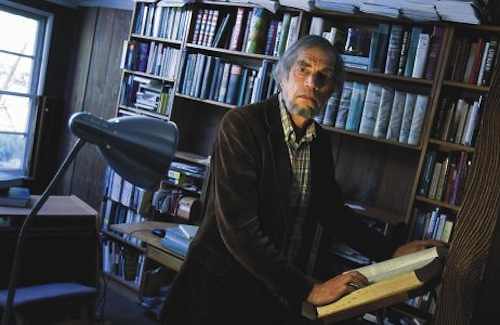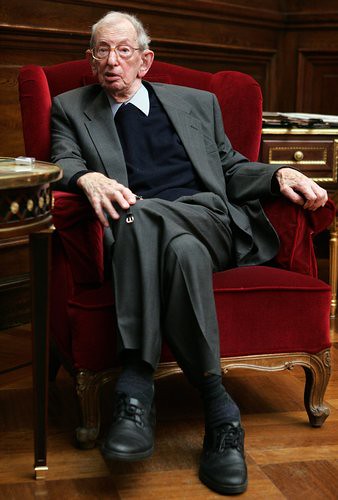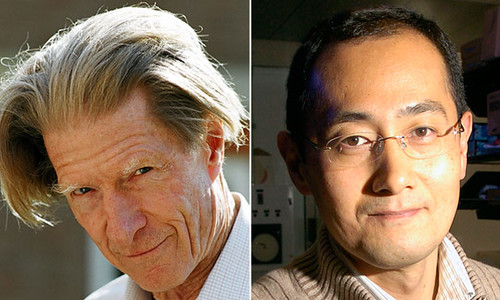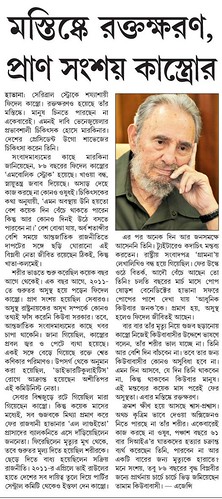মুক্তাঙ্গন-এ উপরোক্ত শিরোনামের নিয়মিত এই সিরিজটিতে থাকছে দেশী বিদেশী পত্রপত্রিকা, ব্লগ ও গবেষণাপত্র থেকে পাঠক সুপারিশকৃত ওয়েবলিন্কের তালিকা। কী ধরণের বিষয়বস্তুর উপর লিন্ক সুপারিশ করা যাবে তার কোনো নির্দিষ্ট নিয়ম, মানদণ্ড বা সময়কাল নেই। পুরো ইন্টারনেট থেকে যা কিছু গুরত্বপূর্ণ, জরুরি, মজার বা আগ্রহোদ্দীপক মনে করবেন পাঠকরা, তা-ই তাঁরা মন্তব্য আকারে উল্লেখ করতে পারেন এখানে।
ধন্যবাদ।
আজকের লিন্ক
এখানে থাকছে দেশী বিদেশী পত্রপত্রিকা, ব্লগ ও গবেষণাপত্র থেকে পাঠক সুপারিশকৃত ওয়েবলিন্কের তালিকা। পুরো ইন্টারনেট থেকে যা কিছু গুরত্বপূর্ণ, জরুরি, মজার বা আগ্রহোদ্দীপক মনে করবেন পাঠকরা, তা-ই সুপারিশ করুন এখানে। ধন্যবাদ।

৪৮ comments
মাসুদ করিম - ২ অক্টোবর ২০১২ (১০:৪০ পূর্বাহ্ণ)
অনেকের নামই মৃত্যুতে প্রথম শুনি, শোকলেখনে প্রথম পড়ি, তেমনি একটি নাম মাইকেল হেনরি হাইম (Michael Henry Heim), ছিলেন সর্বকালের অন্যতম শ্রেষ্ঠ অনুবাদক। তুখোড় দক্ষতা ছিল চেক, ফ্রেঞ্চ, জার্মান, ইটালিয়ান, রাশিয়ান, সার্বো-ক্রোয়েশিয়ান ভাষায়। পড়তে পারতেন ডেনিশ, হাঙ্গেরিয়ান, ল্যাটিন, স্লোভাক, রোমানিয়ান, স্প্যানিশ। গত ২৯ সেপ্টেম্বর ২০১২ সালে মস্তিষ্কের ক্যান্সারের সাথে তার দীর্ঘ লড়াইয়ের পর তিনি মৃত্যুবরণ করেন।

Michael Henry Heim (January 21, 1943 – September 29, 2012)
মাসুদ করিম - ৩ অক্টোবর ২০১২ (১:২৯ অপরাহ্ণ)
গত সোমবার ৯৫ বছর বয়সে প্রয়াত হলেন ইতিহাসবিদের ইতিহাসবিদ খ্যাত শিল্পবিপ্লবের ইতিহাস অসাধারণ জীবন্ত লেখার মাধ্যমে প্রকাশ করা মহান ইতিহাস কথক কমিউনিস্ট কিন্তু আধুনিক সংস্কৃতির গণতান্ত্রিক অনুপ্রেরণায় ঋদ্ধ ব্রিটিশ ইতিহাসবিদ এরিক হবসবম (Eric Hobsbawm)।

Eric Hobsbawm (9 June 1917 – 1 October 2012)
রেজাউল করিম সুমন - ৬ অক্টোবর ২০১২ (১:১২ পূর্বাহ্ণ)
আরো দুটি শোকলেখন:
Remember us with forbearance: the unrepentant Eric Hobsbawm, an obituary
Historian in the Marxist tradition with a global reach
মাসুদ করিম - ৬ অক্টোবর ২০১২ (১:৪১ অপরাহ্ণ)
শন কোনারি, Diamonds Are Forever।
জেমস বন্ডের ৫০ বছর উদযাপন চলছে। ব্রিটিশ দৈনিক ‘গার্ডিয়ান’এর এই ডাটাব্লগটি আমার খুবই ভাল লেগেছে। এই পঞ্চাশ বছরে কতজনকে মরতে হয়েছে জেমস বন্ড ফিল্মে? — ১২৯৯ জনকে, ২২টি টি ফিল্মে (অফিসিয়াল) গড়ে ৫৯ জন করে, এর মধ্যে জেমস বন্ড একাই মেরেছে ৩৫২ জনকে আর অন্যরা মেরেছে ৯৪৭ জনকে। সবচেয়ে ‘ডেডলি’ ফিল্ম ছিল You Only Live Twice, এফিল্মে বন্ড মেরেছেন ২১ জন অন্যরা মেরেছে ১৭৫ জন, সব মিলিয়ে ১৯৬টি লাশ পড়েছিল এফিল্মে। ডাটা ডাউনলোড করুন : James Bond movie body counts।
Deaths by film
ডাটাব্লগটি সম্পূর্ণ পড়ুন : James Bond bodycount: how many people died in each film?
অদিতি কবির - ৬ অক্টোবর ২০১২ (৪:৫০ অপরাহ্ণ)
শ্যন কনারির পাশে দাঁড়ান মেয়েটি লানা উড। নাটালি উডের বোন।
মাসুদ করিম - ৬ অক্টোবর ২০১২ (৬:০০ অপরাহ্ণ)
মাসুদ করিম - ৭ অক্টোবর ২০১২ (১০:২৩ অপরাহ্ণ)
আজ দ্বাদশ বর্ষে প্রবেশ করল আফগান যুদ্ধ।
বিস্তারিত পড়ুন : Afghanistan war enters 12th year।
মাসুদ করিম - ৮ অক্টোবর ২০১২ (৯:৩১ পূর্বাহ্ণ)
চতুর্থ বারের মতো ভেনিজুয়েলার প্রেসিডেন্ট নির্বাচিত হলেন হুগো শাভেজ।
বিস্তারিত পড়ুন : Chavez wins Venezuelan presidency।
মাসুদ করিম - ৮ অক্টোবর ২০১২ (১২:৫৫ অপরাহ্ণ)
২০০৭এ বুকারে : চিনুয়া আচেবে
চিনুয়া আচেবের আত্মজীবনী,There Was a Country, আলোকপাত করা হয়েছে মূলত ১৯৬৭-৭০এর নাইজেরিয়ার গৃহযুদ্ধের স্মৃতিকে, বাজারে আসবে ১১ অক্টোবর ২০১২।
মাসুদ করিম - ৮ অক্টোবর ২০১২ (৬:২৩ অপরাহ্ণ)
পরিণত দেহকোষ আবার প্রোগ্রাম করা যাবে! এই আবিষ্কারের জন্য এবারের চিকিৎসাবিজ্ঞানের নোবেল পেলেন জাপানের শিনইয়া ইয়ামানাকা এবং ব্রিটেনের স্যার জন বি. গার্ডন।

A female Xenopus frog – the first sexually mature adult vertebrate produced by nuclear transplantation – which Gurdon created in the 1950s. Photograph: J B Gurdon
মাসুদ করিম - ১৪ অক্টোবর ২০১২ (১২:৩৩ অপরাহ্ণ)
মুক্তমনায় প্রদীপ দেব : চিকিৎসাবিদ্যায় নোবেল পুরষ্কার ও একটি সনদপত্র।
মাসুদ করিম - ৯ অক্টোবর ২০১২ (১২:৫৯ অপরাহ্ণ)
গ্রিসের সাথে সংহতি প্রকাশে বিলম্ব হল এঙ্গেলা মারকেলের? আজ তার গ্রিস সফরে এটাই মূল প্রশ্ন।
বিস্তারিত পড়ুন : Merkel Ventures to Athens in Late Show of Solidarity।
মাসুদ করিম - ৯ অক্টোবর ২০১২ (২:৩৯ অপরাহ্ণ)
চেতনা। বস্তু। মস্তিষ্ক। মন। সমন্বিত তথ্য। মনন। আত্মা। বড় কঠিন পরিক্রমা। একজন স্নায়ুবিজ্ঞানী গ্যালিলিওর স্বপ্নের অভিযাত্রার প্রবাদ লিখলেন।
মাসুদ করিম - ৯ অক্টোবর ২০১২ (৫:১৯ অপরাহ্ণ)
সূক্ষ্মতম ঘড়ি ও অত্যন্ত দ্রুতগতির কম্পিউটার তৈরিতে যেআবিষ্কার কাজে লাগবে সেই বস্তুগত কোয়ান্টাম প্রক্রিয়ার পরিমাপণ ও হস্তক্ষেপণের পদ্ধতির দুই গবেষক, একজন ফরাসি সের্জ আরশ আরেক জন আমেরিকান ডেভিড জে. ওয়াইনল্যানড, এবারের পদার্থবিজ্ঞানের নোবেল পেলেন।
David J. Wineland | Serge Haroche
মাসুদ করিম - ১০ অক্টোবর ২০১২ (৬:০০ অপরাহ্ণ)
রসায়নে নোবেল দুই আমেরিকানের। ভবিষ্যতে আরো কার্যকরী ওষুধ বানাতে অবদান রাখবে রবার্ট জে. লেফকোউইটজ ও ব্রায়ান কে. কোবাইলকারের প্রোটিন রিসেপ্টর কিভাবে দেহের কোষকে বাইরের সংকেত অনুভব করতে ও সাড়া দিতে সহায়তা করে এবিষয়ক গবেষণালব্ধ পর্যবেক্ষণ।
Robert J. Lefkowitz | Brian K. Kobilka
মাসুদ করিম - ১১ অক্টোবর ২০১২ (৫:৩৬ অপরাহ্ণ)
লোককথা, ইতিহাস ও সমসাময়িকতাকে একাকার করে এক বিভ্রমবাস্তব গাথা রচনা করেন চীনের লেখক মো ইয়ান, এবং তিনিই এবারের সাহিত্যের নোবেল বিজয়ী।

Mo Yan | 莫言 | Mò Yán
এখানে আমাজনের লুক ইনসাইডে : মো ইয়ানের বিখ্যাত উপন্যাস Red Sorghum।
চীনের রাষ্ট্রীয় সংবাদসংস্থা চিনহুয়ার মো ইয়ানকে নিয়ে ফটোগ্যালারি
CCTV: Mo Yan Feature
মাসুদ করিম - ১২ অক্টোবর ২০১২ (১২:১৩ অপরাহ্ণ)
যখন অর্থ ‘কথা বলো না’ তখন ছদ্মনাম হিসেবে ‘মো ইয়ান’ খারাপ নয়। এখন প্রশ্ন হচ্ছে চীনের ভগবানরা নিদ্রা গিয়েছেন তাদের ঘুমের ক্ষতি হবে বলে বলা হচ্ছে ‘কথা বলো না’, নাকি গুয়ান মোয়ে আমাদের বলতে চান চীনের রাগী ভগবানেরা কথা শুনতে চান না তাই তোমরা কেউ ‘কথা বলো না’। চীনের ক্ষমতাসীনদের ‘মো ইয়ান’কে পছন্দ হয়েছে, এখন দেখা যাক শেষ পর্যন্ত চীনের ‘নোবেল কমপ্লেক্স’ এই লেখককে কোথায় নিয়ে যায়।
মো ইয়ানের বাবা গুয়ান ইফান (৯০) গাওমিতে তাদের গ্রামের বাড়িতে। প্রতিদিনের মত আজ সকালেও তিনি তার চাষেরক্ষেতে কাজ করছিলেন।
মাসুদ করিম - ১২ অক্টোবর ২০১২ (১:৪৯ অপরাহ্ণ)
এর মধ্যেই চীনের শিল্পী আই ওয়েইওয়েই মো ইয়ানকে সাহিত্যের নোবেলে ভূষিত করায় নোবেল কমিটির সমালোচনা করে টুইট করেছেন।
জার্মান পত্রিকার সাথে কথা বলতে গিয়ে আই ওয়েইওয়েই বলেছেন
মাসুদ করিম - ১৩ অক্টোবর ২০১২ (২:৩৩ অপরাহ্ণ)
একটু কেমন যেন আন্কেল মো আন্কেল মো! গ্রানটা ম্যাগে মো ইয়ানের সাক্ষাৎকার : Granta Audio: Mo Yan।
মাসুদ করিম - ১৩ অক্টোবর ২০১২ (৭:০৭ অপরাহ্ণ)
তার চেয়ে ফরাসি জানা থাকলে এটা পড়া যেতে পারে, অনেক ইন্টারেস্টিং : Mo Yan, prix Nobel de littérature।
মাসুদ করিম - ১১ অক্টোবর ২০১২ (৭:৪৭ অপরাহ্ণ)
মজেনা তো বলছেন, US team coming to explore shale gas prospects।
তাহলে হিলারি ক্লিন্টন কথার টানে শেইল গ্যাসের কথা বলেননি।
এই মানচিত্র কতটুকু আপডেটেড জানি না। কিন্তু ‘শেইল গ্যাস’এর এই মানচিত্র অনুযায়ী বাংলাদেশ ‘গ্রে জোনে’: Countries out side scope of report। তার মানে এখন রিপোর্ট করার জন্য ‘স্কোপ’ হতে চলেছে? দেখা যাক।
মাসুদ করিম - ১২ অক্টোবর ২০১২ (৩:১৮ অপরাহ্ণ)
এবারের শান্তির নোবেল প্রতিষ্ঠানের ঘরে, পেল ইউরোপিয়ান ইউনিয়ন : ছয় দশকের ওপরে শান্তি গণতন্ত্র মানবাধিকার নিয়ে অব্যাহত কর্মকাণ্ডের স্বীকৃতি স্বরূপ।

মাসুদ করিম - ১৩ অক্টোবর ২০১২ (১২:২৪ পূর্বাহ্ণ)
হুগো শাভেজ জেতার পরে ফিদেল কাস্ত্রোর কোনো অভিনন্দন বার্তা দেখা যায়নি এর ভিত্তিতে তার শারীরিক অবস্থা নিয়ে আবার গুঞ্জন, কাস্ত্রোর এক পুত্র বলছেন কাস্ত্রো ভাল আছেন।
মাসুদ করিম - ২১ অক্টোবর ২০১২ (৭:৪৩ অপরাহ্ণ)
কাস্ত্রোর মস্তিষ্কে রক্তক্ষরণ, শোনা যাচ্ছে, অফিসিয়ালি কিছু জানার উপায়ও নেই, বৃদ্ধ বিপ্লবীর জন্য প্রার্থনা করছে কিউবাবাসীরা গির্জায় গির্জায়। পড়ুন এখানে।

খবরের লিন্ক এখানে।
এইমাত্র অ্যাসোসিয়েটেড প্রেসের টুইট
মাসুদ করিম - ২১ অক্টোবর ২০১২ (১১:৪৮ অপরাহ্ণ)
অ্যাসোসিয়েটেড প্রেসের খবর : Hotel official: Fidel Castro appears in public।
মাসুদ করিম - ১৪ অক্টোবর ২০১২ (৬:৩৬ অপরাহ্ণ)
প্রত্যেকটি অর্থঅপরাধের কারিগরি দিকের খোঁজ নিতে গেলে আর্থিক প্রতিষ্ঠানের একটা ঢালাওভাবে ব্যবহৃত মূল মুনাফা অর্জনকারী ‘টুল’ বেরিয়ে আসে। যেমন আমেরিকার ২০০৮এর ‘সাবপ্রাইম লোন’, যেমন বাংলাদেশের ২০১১এর ‘প্রিআইপিও+অমনিবাস অ্যাকাউন্ট’ এবং এবারের হলমার্কের ঋণজালিয়াতির ‘আইবিপি – মানে ‘ইনল্যান্ড বিল পার্চেজ’। এবং এটা শুধু সোনালী ব্যাংককেই নয়, এখনই এই টুলের বড় রকম সংস্কার না করলে বাংলাদেশের অর্থব্যবস্থাকেই একটা বড় সমস্যার সম্মুখীন করবে। তাই একে শুধু হলমার্কের ঋণজালিয়াতি হিসাবে না দেখে ‘আইবিপি’ সংকট হিসাবে দেখা উচিত।
মাসুদ করিম - ১৪ অক্টোবর ২০১২ (৬:৪৭ অপরাহ্ণ)
অপু দুর্গার বাড়িতে কিভাবে ভ্রমণে যাবেন, তার বিবরণ। পড়ুন এখানে।
মাসুদ করিম - ১৫ অক্টোবর ২০১২ (১০:১৭ পূর্বাহ্ণ)
এটাকে কি লাফ বলা যায়? ‘ফ্রিফল’ই সই, ১২০০০০ ফুট উপর থেকে ডাইব, আহা, ফেলিক্স বাউমগার্টনার তোমার মতো এই মুক্তপতনের অভিজ্ঞান হয়তো কখনো নিতে পারব না — কিন্তু যা দেখলাম তার কোনো তুলনা হতে পারে না।
বিস্তারিত পড়ুন, ছবি ও ভিডিও দেখুন : Felix Baumgartner Photos: Pictures Of Sunday’s Record-Breaking Parachute Jump।
মাসুদ করিম - ১৫ অক্টোবর ২০১২ (১২:৩৬ অপরাহ্ণ)
গতির রেকর্ড করেছেন ফেলিক্স বাউমগার্টনার মাটি স্পর্শ করার আগের শেষ দশ মিনিট ৮৩৩.৯ মাইল/ঘন্টা আর ইউটিউবে হয়েছে অনলাইনে দেখার রেকর্ড ৮০ লাখ লোক একসাথে দেখেছে এবং ইউটিউবের জন্য দুঃখজনক আমাদের দেশে ইউটিউব নিষেধাজ্ঞার (আমাদের দেশের জন্য এটা লজ্জাজনক বললেও কম বলা হবে) কারণে দেখার সংখ্যার রেবকর্ডটি আরো বড় হল না।
মাসুদ করিম - ১৫ অক্টোবর ২০১২ (৬:৪৬ অপরাহ্ণ)
অর্থনীতির নোবেল ধরাবাঁধা আমেরিকান তাত্ত্বিকদের জন্য এবং গেমথিওরির জন্য। লয়েড এস. শ্যাপলে এবং আলভিন ই. রথ দুজনেই একই ‘Stable allocations’ থিওরি নিয়ে স্বাধীনভাবে নিজ নিজ থিওরি প্রদান করার জন্য এই পুরস্কার পাবেন। শ্যাপলে (ইউনিভার্সিটি অফ ক্যালিফর্নিয়া) প্রধানত কাজ করেছেন সমবায় সমিতি নিয়ে, সমবায় সমিতিগুলোতে নির্দিষ্ট সদস্যরা যারা তাদের গন্ডির বাইরে কাউকে নিয়ে কাজ করতে উৎসাহী নয় তারা কিভাবে ‘Stable allocations’ থিওরি ব্যবহার করে পারষ্পরিক সর্বোচ্চ লাভের সুযোগ পেতে পারে — এটাই তিনি গেমথিওরি দিয়ে প্রতিপন্ন করেছেন। রথ (হাভার্ড ইউনিভার্সিটি) ‘Stable allocations’ থিওরিকে হাতে কলমে ব্যবহার করেছেন — একজন ডাক্তার কিভাবে তার জন্য সর্বোচ্চ ফলদায়ক হাসপাতাল, একজন অর্গানদাতা কীকরে সবচেয়ে কাঙ্ক্ষিত গ্রহীতা ও একজন ছাত্র কীকরে তার সাথে সর্বোচ্চ খাপখাওয়া শিক্ষাঙ্গন খুঁজে পেতে পারে এই কাজে।
মাসুদ করিম - ১৬ অক্টোবর ২০১২ (৯:৫৩ পূর্বাহ্ণ)
মাসুদ করিম - ১৬ অক্টোবর ২০১২ (১২:৪৪ অপরাহ্ণ)
সেপ্টেম্বর ১১, ২০১২এর রাতে লিবিয়ার বেনগাজিতে আমেরিকার দূতাবাসে হামলা নিয়ে আমেরিকার প্রেসিডেন্ট নির্বাচনের রিপাবলিকান প্রচার উত্তপ্ত হয়ে উঠেছে গত কয়েকদিন ধরেই। এতে সরাসরি ক্ষমতাসীন ডেমোক্রেট প্রেসিডেন্ট ও ভাইস-প্রেসিডেন্টকে দায়ী করা হচ্ছিল এবং হিলারি ক্লিন্টনের দায়িত্বে অবহেলার কথা বলা হচ্ছিল। এপ্রসঙ্গে হিলারির নিশ্চুপ থাকায় দলের উপর আরো চাপ বাড়ছিল। শেষ পর্যন্ত গতকাল সিএনএন-এর সাথে সাক্ষাৎকারে হিলারি মুখ খুললেন এবং বেনগাজির দূতাবাসে নিরাপত্তায় অবহেলার সব দায় তার নিজের বলে উল্লেখ করলেন।
মাসুদ করিম - ১৭ অক্টোবর ২০১২ (১২:৫৬ অপরাহ্ণ)
হিলারির পর এবার ওবামাও বললেন, লিবিয়িায় বেনগাজির আমেরিকান দূতাবাসে নিরাপত্তা ব্যর্থতার দায় তারও যেহেতু তিনি প্রেসিডেন্ট এবং হিলারি তার হয়েই কাজ করেন।
মাসুদ করিম - ১৭ অক্টোবর ২০১২ (১:২১ অপরাহ্ণ)
ইদের আগে লঞ্চে একটু রঙের প্রলেপ। এই, এর চেয়ে আর বেশি কিছু কি করতে হয়, করে লঞ্চ কোম্পানিগুলো? আর এই করেই পুরনো লক্কড়ঝক্কড় লঞ্চের ‘ফিটনেস’ ছাড়পত্রও নিশ্চয় পেয়ে যায় প্রশাসন থেকে?
মাসুদ করিম - ১৮ অক্টোবর ২০১২ (১০:৩৫ পূর্বাহ্ণ)
Mitt Romney যাকে আমি বাংলায় অনুবাদ করেছিলাম ‘রমণীমোহন মিত্র’ এবং নামের সাথে তার চেহারা নিয়ে কটাক্ষ করেছিলাম — মিন্সের যা চেহারা, দ্বিতীয় প্রেসিডেন্সিয়াল বিতর্কে নারী পুরুষের কর্মক্ষেত্রে সমান অধিকারের প্রশ্নে তিনি এভাবে রমণী বাইন্ডার হিসাবে বিশ্ববিশ্রুত হবেন এবং নারীদের অধিকারের বিরুদ্ধে তার দাঁত এভাবে বেরিয়ে পড়বে সত্যিই ভাবিনি।
‘Binders full of women’ Dave Granlundএর কার্টুন
তার এই উক্তির পর তাৎক্ষণিকভাবে তৈরি টুইটার হ্যান্ডেল @RomneyBinders কিছু টুইট
মাসুদ করিম - ১৮ অক্টোবর ২০১২ (১২:৪৩ অপরাহ্ণ)
রপ্তানি পণ্যের বৈচিত্রের উপরই নির্ভর করছে বাংলাদেশের অর্থনীতির ভবিষ্যৎ, আমরা একথা বারবার আলোচনায় তুলছি, এবং সরকারও বলছে সরকার এবিষয়ে লক্ষ্য স্থাপন করেছে। কিন্তু কথা হল ঠিক কিভাবে পলিসি নির্ধারণ করা হচ্ছে তার এখনো কোনো স্পষ্ট ছবি আমরা পাচ্ছি না। শ্রমের মূল্য নিয়ে প্রচুর কাজ করার আছে, কারণ শুধু কম শ্রমের মূল্য দিয়ে কতটুকু গভীর দীর্ঘমেয়াদি শিল্পায়ন হবে তাতে যথেষ্ট সন্দেহ আছে। আর জনশক্তি রপ্তানি নিয়ে গতানুগতিক অবস্থানে আর কত দিন পড়ে থাকবে বাংলাদেশ, পরবর্তী প্রজন্মের জনশক্তি রপ্তানি উদ্ভাবনা সম্ভব না হলে এখাত থেকেও বাংলাদেশের প্রবৃদ্ধি বাধাগ্রস্ত হবে। আর অবকাঠামো নির্মাণ নিয়ে বাংলাদেশে একটা স্থবিরতা বিরাজ করছে, স্পষ্টত এমন স্থবিরতা দীর্ঘস্থায়ী হলে বাংলাদেশের উন্নতির গল্প আপনি ধ্বসে পড়বে। পড়ছিলাম WTO reviews Bangladesh’s trade policies & practices , এটা পড়তে পড়তেই এভাবনাগুলো আসল।
মাসুদ করিম - ১৮ অক্টোবর ২০১২ (২:৪৪ অপরাহ্ণ)
দারিদ্রপীড়িত বার্মার গ্রামগুলো থেকে অবাধে নারীপাচার হচ্ছে অস্ট্রেলিয়ায় বেবিসিটারের কাজের প্রলোভন দেখিয়ে। তাদের নিয়ে যাওয়া হচ্ছে থাইল্যান্ডকে ট্রানজিট হিসাবে ব্যবহার করে এবং থাইপুলিশের গোপন সহায়তায়। অস্ট্রেলিয়ায় নিয়ে যাওয়ার পর ওদেরকে বিক্রি করে দেয়া হচ্ছে যৌনকর্মী হিসাবে। বিস্তারিত পড়ুন এখানে।
মাসুদ করিম - ১৮ অক্টোবর ২০১২ (৩:০৯ অপরাহ্ণ)
এক নেতা তার জন্মদিন নিয়ে ঘোল পাকিয়েছেন এটা তারা নিশ্চয় জানে তাই আরেক নেতার জন্মদিনও প্রোফাইল থেকে বাদ দিয়ে দিয়েছে চীনের রাষ্ট্রীয় সংবাদসংস্থা চিনহুয়া।
এটা কিন্তু চিনহুয়ার কালচার নয় যে তারা জন্মদিন বাদ দিয়ে প্রোফাইল করে। দেখুন মনমোহন সিংয়ের প্রোফাইল।
চিনহুয়ার খালেদার প্রোফাইলে আরো লেখা আছে
হাসিনার প্রোফাইলে এরশাদবিরোধী আন্দোলনে তার অংশগ্রহণ নিয়ে কিছু লেখা নেই। চিনহুয়ার প্রোফাইল পড়লে যেকারো মনে হবে খালেদা একাই এরশাদকে ক্ষমতা থেকে হটিয়েছিলেন এবং এরশাদের সব নির্যাতন তিনি একাই সয়েছিলেন।
মাসুদ করিম - ১৯ অক্টোবর ২০১২ (২:৫৩ অপরাহ্ণ)
খালেদা জিয়ার চীন সফরের সবচেয়ে গুরুত্বপূর্ণ বৈঠকটি হয়েছে গতকাল চীনের বর্তমান ভাইস প্রেসিডেন্ট এবং ভবিষ্যতের সম্ভাব্য প্রেসিডেন্ট চি জিনপিং-এর সাথে। এনিয়ে আমাদের দেশের পত্রিকাগুলো লিখেছে। কিন্তু চীনের রাষ্ট্রীয় সংবাদ সংস্থা চিনহুয়া কী লিখেছে তাও আমাদের পড়ে রাখা উচিত। কোনো গূঢ় কারণে নয় শুধুমাত্র রেকর্ড রাখার জন্য।
মাসুদ করিম - ১৯ অক্টোবর ২০১২ (১১:৩৮ অপরাহ্ণ)
পৃথিবীটা কি আবার বোমা হামলার শিরোনামের দখলে চলে যাচ্ছে? আজ বৈরুতের খ্রিস্টান অধ্যুষিত এলাকায় শক্তিশালী গাড়ি বোমার আঘাতে লেবাননের নিরাপত্তা বাহিনীর প্রধানসহ আটজন নিহত হয়েছেন এবং প্রায় ৭৮ জন আহত হয়েছেন।
বিস্তারিত পড়ুন : Security chief dies in Beirut blast – live updates।
মাসুদ করিম - ২০ অক্টোবর ২০১২ (৩:০৫ পূর্বাহ্ণ)
চীনের কবি লিআও ইউ-এর (LIAO YIWU) এই বক্তৃতাটি কবিতাই মনে হচ্ছে। পিস প্রাইজ অফ জার্মান বুক ট্রেডের পুরস্কার গ্রহণে সম্মতি প্রদান করে তিনি যেবক্তৃতাটি দিয়েছেন তা অবলম্বনে নিচের লেখাটি তৈরি করা হয়েছে।
Liao Yiwu | 廖亦武
মাসুদ করিম - ২১ অক্টোবর ২০১২ (৬:১৩ অপরাহ্ণ)
চীনের কমিউনিস্ট পার্টির পলিটব্যুরোর কেন্দ্রীয় স্ট্যান্ডিং কমিটির সদস্য এবং চীন সরকারের প্রপাগান্ডা প্রধান লি চ্যাংচুন বাংলাদেশ আওয়ামী লীগের আমন্ত্রণে বাংলাদেশে এসেছেন গতকাল, এনিয়ে চিনহুয়ার রিপোর্ট।
লি চ্যাংচুনকে বিমানবন্দরে অভ্যর্থনা জানাচ্ছেন আওয়ামী লীগ নেতারা
মাসুদ করিম - ২২ অক্টোবর ২০১২ (১০:১৫ পূর্বাহ্ণ)
১৯৬২ সালের চীন-ভারত যুদ্ধের ৫০ বছর নিয়ে দুই সরকারই চুপ, চীন সরকার চুপ হলে চীনের রাষ্ট্রীয় মিডিয়াও চুপ এটাই স্বাভাবিক কিন্তু ভারতে তো মিডিয়া রাষ্ট্রীয় নয় — সেখানে কথা হচ্ছে। ভারতের চন্ডিগড়ের ইংরেজি দৈনিক’দি ট্রিবিউন’এর ১৯৬২ সালের যুদ্ধ নিয়ে সম্পাদকীয় বিশেষ আয়োজনের জরাওয়ার দৌলত সিং-এর Why India and China went to war in 1962 লেখাটি পড়ে এবিষয়ে বিস্তৃতভাবে জানা গেল।
মাসুদ করিম - ২৩ অক্টোবর ২০১২ (৯:৩২ পূর্বাহ্ণ)
ইতিহাস উপন্যাস ভ্রমণ বিনোদনের শ্রেষ্ট কথাকার ও এক প্রজন্মের ভালবাসার কবি সুনীল গঙ্গোপাধ্যায় চলে গেলেন যখন তার কর্মক্ষেত্র কলকাতায় সংবাদমাধ্যমও পূজোয় মগ্ন। আগামীকাল শুধু বাংলাদেশের পত্রিকার লিড নিউজ হবেন সুনীল এটা ইতিহাসের উপাদান হয়ে থাকবে মুত্যুপরবর্তী সুনীলের জন্য।
সুনীলের ব্লগ : বিজনে নিজের সঙ্গে দেখা
দুই বাংলার সেতুপুরুষ | সুনীল স্মরণে অলোকরঞ্জন | প্রাত্যহিক খবর | পড়ুন এখানে।
খবরের লিন্ক : সুনীল গঙ্গোপাধ্যায়ের চিরপ্রস্থান।
মাসুদ করিম - ২৩ অক্টোবর ২০১২ (১০:৪১ অপরাহ্ণ)
রাশিয়ায় ‘লাল’ ভোর ফুটবে আবার, স্বাধীনতা ও মানবাধিকারের জন্য সোভিয়েত শাসনকে বিতাড়িত করে আখেরে গোষ্ঠীর ধান্দাবাজি শাসনে আজো বিপর্যস্ত রাশিয়া, সেই অসাম্যের বিরুদ্ধে তারুণ্যের মধ্যে শোনা যাচ্ছে আবার ‘লাল’এর প্রতিধ্বনি — হ্যাঁ, তারাও বলছে ওই একই সোভিয়েত ‘লাল’ ফিরে আসুক তারাও চায় না তারা আনতে চায় নতুন ‘লাল’। আমরাও আশা করি রাশিয়া তেমন কোনো নতুন ‘লাল’কেই আনুক যা তারুণ্যের আকাঙ্ক্ষার সাথে হবে সঙ্গতিপূর্ণ কিন্তু একই সাথে তা যেন ‘বিশ্বায়ন’ভাবুক (যাতে বিশ্বায়নকে নতুন তাৎপর্য দেয়া যায় সত্যিকার অর্থেই তাকে মাল্টিপোলার করা যায়) হয় ‘বিশ্বায়ন’বিমুখ না হয়।
বিস্তারিত পড়ুন : Russia’s Rising Red Dawn।
মাসুদ করিম - ২৮ অক্টোবর ২০১২ (১২:৩৭ অপরাহ্ণ)
চীনের প্রধানমন্ত্রী ওয়েন জিয়াবাও একজন সহজ সরল মানুষের প্রতিমূর্তি নিয়ে চলেন, চীনের মিডিয়া উচ্চকিত করে তার সুবিধাবঞ্চিতদের প্রতি একাত্ম ‘গ্র্যান্ডপা’ ইমেজ, চীনের কমিউনিস্ট পার্টির প্রচারযন্ত্র বলে নেতাদের অসৎ অর্থ উপার্জনের বিরুদ্ধে তিনি উচ্চকণ্ঠ, কিন্তু তার প্রধানমন্ত্রীত্বের তলে পারিবারিক সদস্যদের মাধ্যমে অসততার নিরন্তর চর্চায় পারিবারিক সাম্রাজ্যের যে রিপোর্ট সম্প্রতি প্রকাশিত হল নিউইয়র্ক টাইমসে, তাতে চীনের এলিট রাজনীতিবিদদের গোপন অসৎ কার্যক্রমই শুধু উন্মোচিত হয়নি ধান্দার রাষ্ট্রনিয়ন্ত্রিত সমাজতান্ত্রিক অর্থনীতি কিভাবে চলে তারও স্বরূপ উন্মোচিত হয়েছে। প্রায় তিন বিলিয়ন ডলারের সাম্রাজ্য গড়েছেন ওয়েন জিয়াবাও-এর পরিবার, যার মধ্যে ওয়েন জিয়াবাও-এর দরিদ্র স্কুলশিক্ষিকা মায়ের দখলেই আছে ১১০ মিলিয়ন ডলারের সম্পত্তি।
একনজরে গ্রাফিক্সে দেখুন ওয়েন জিয়াবাওর পারিবারিক সাম্রাজ্য।
বিস্তারিত সম্পূর্ণ রিপোর্টটি পড়ুন : Billions in Hidden Riches for Family of Chinese Leader।
মাসুদ করিম - ৩০ অক্টোবর ২০১২ (২:৪৫ পূর্বাহ্ণ)
Brueghel
ফ্লেমিশ স্বর্ণযুগের অসাধারণ দশটি পেইান্টং দেখুন এখানে।
মাসুদ করিম - ৩১ অক্টোবর ২০১২ (৩:০৬ অপরাহ্ণ)
অন্য ধর্মের ঐতিহাসিক স্থানের প্রতি সৌদি প্রশাসকদের শ্রদ্ধার তো কোনো প্রশ্নই আসে না ইসলামের ইতিহাস ও মুহম্মদের সমাধি এবং তার জীবনের সাথে জড়িত গুরুত্বপূর্ণ স্থানসমূহের এবং খলিফাদের সমাধি ও স্মৃতিজড়িত বিভিন্ন জায়গাও এখন আর ওয়াহাবি সৌদিদের হাতে নিরাপদ নয়। মদিনার মসজিদ-ই-নববীর মানুষ ধারনক্ষমতা ৬০০০০ থেকে বাড়িয়ে ১০৬০০০০ করতে গিয়ে ওয়াহাবি বুলডজারের আঘাতে কী কী ধ্বসে পড়বে, পড়ুন।